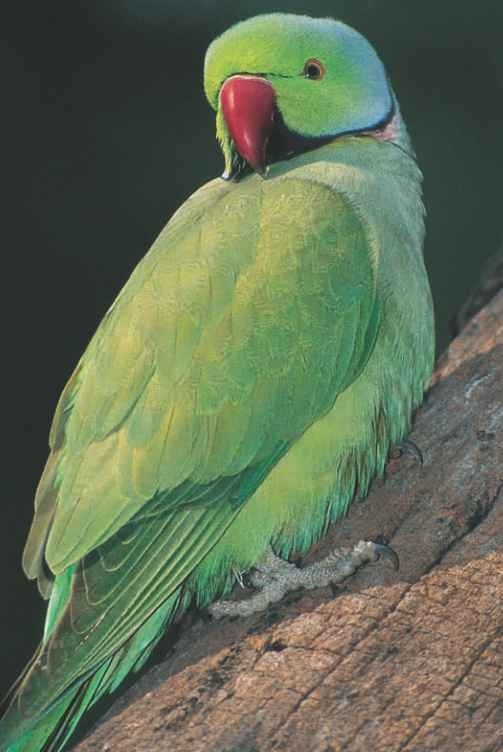ORDER
Psittaciformes
FAMILY
Psittacidae
GENUS & SPECIES
KEY FEATURES
• Most widespread of all the parrots
. • Roosts and feeds in hundreds-strong flocks, which can devastate fruit and cereal crops
• Thrives in cities and in countries far from its normal tropical range, including Britain
• Pairs mate for life and make their nest in a snug hole in a tree or wall
WHERE IN THE WORLD?
Found in southern Asia, from eastern Pakistan and India east to Burma (Myanmar), and in a band across Africa, from Senegal to Somalia; introduced to parts of Europe, Middle East, ‘ China and the U.S.

Lifecycle
The rose-ringed parakeet is bold and adaptable enough to profit from human activities. It flourishes in cities and has escaped from captivity to colonize new areas.
Habitat
The rose-ringed parakeet prefers lightly wooded country in the lowland plains of tropical Asia and Africa, but it occurs up to 6,600′ in the Himalayas and the Ethiopian highlands. In rural India, the parakeet lives in areas of lush vegetation, breeding in deciduous forests. In much of its African range, however, the species is found in savannah woodland and arid, thorny scrub. The rose-ringed parakeet lives near human habitation, since farmland, parks and gardens provide it with easy pickings. A huge parakeet population lives in the cities of northern India and Pakistan.

A Plains living
Typical parakeet habitat is open woodland in Ethiopia.
The rose-ringed parakeet is sometimes called the ring-necked parakeet.
The naturalized rose-ringed parakeet in Miami,
Florida, is one of only a few birds that nest in winter. The male and female pair up in late December.
The rose-ringed parakeet is not a popular cagebird due to its raucous calls and tendency to bite, but captive birds have been bred with striking yellow, blue, white, gray and even black-and-white plumages.
Behavior
It’s unusual to see the rose-ringed parakeet alone or in a pair, except in the breeding season. For most of the year, the bird lives in flocks, which may be thousands-strong in parts of India. The parakeet squabbles frequently with its companions, but fights are rare, as they reserve their aggression for driving away predators, such as hawks. The parakeets all join in to mob their enemy, flapping their wings, pecking and screaming until it retreats.
The agile parakeet uses its bill like a third foot when climbing. It stretches its neck out and takes a hold on a suitable branch with its bill, before following with its feet. The parakeet uses a similar method when walking on a narrow perch.
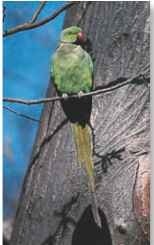
A Sitting pretty A long tail and opposing toes help the parakeet perch on thin branches.
Food & feeding
The rose-ringed parakeet lives in places where there’s an abundance of nuts, seeds and fruity supplemented by other crops, such as wheat, maize, coffee, dates, figs and guavas. These foods ripen at different times, sustaining the parakeet throughout the year If food is scarce due to a failed crop, for example, the parakeet leaves its home range to eat whatever plant matter it finds.
Large flocks of the rose-ringed parakeet gather to feast on heavily laden fruit trees or spilled grain. The birds themselves have learned how to tear open sacks of grain or rice in farmyards and railway depots.

Get stuck in The hooked bill can rip tough-skinned fruit (far right) and open hard-shelled nuts.
parrot fashion
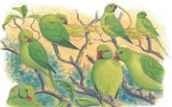
Opening movement…
An hour or so before sunset, a group of rose-ringed parakeets has gathered in the treetops. They call excitedly and preen each other.
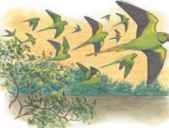
Chorus…
As night approaches, different groups of parakeets take to the air, until hundreds of screeching birds are circling the area together.
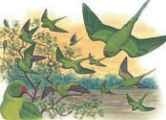
Crescendo…
Still screaming, the expanded flock lands in some tall trees to roost. Sites like this are often used by successive generations.
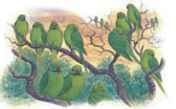
Silent night
After jostling each other for the best perches, the parakeets begin to settle down for the night.The birds stay quiet until daybreak.
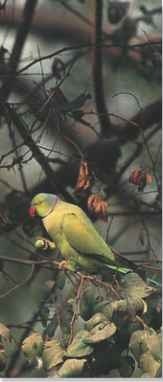
conservation
Far from being threatened, as is the case with many parrot species, the rose-ringed parakeet is itself a major pest for farmers as well as other wildlife in India, Pakistan and elsewhere.The parakeet has a habit of taking just a few bites from each fruit before discarding it and plucking another one, so the species can seriously damage fruit crops. In Europe, it often out-competes native birds for both food and nest sites.|
Breeding
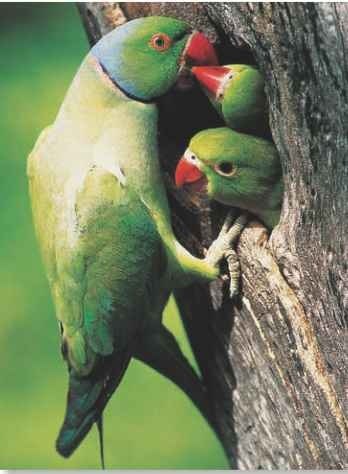
A Greenhouse Young birds lack collars, so they look more like the female than the male (above).
Pairs of rose-ringed parakeets stay together for life, but the male and female renew their pair bond every year During the courtship display, the male approaches his mate while fanning his tail and repeatedly dilating, then contracting the pupils of his eyes. The male feeds the female beak to beak; she rolls her eyes and rubs bills with her partner:
The rose-ringed parakeet usually nests in an unlined tree hole about 10-33′ above the ground. It often makes use of an old woodpecker hole, which the parakeet may first enlarge with its bill. In urban areas, breeding pairs sometimes nest in holes in walls and buildings, even in noisy areas, such as near a busy street market.
The female incubates the eggs for more than three weeks, while she is fed and guarded by her mate. The naked chicks hatch and their eyes open ten days later: Both parents feed the young for 7-8 weeks, regurgitating partly digested food into their bills.
PROFILE
Rose-ringed Parakeet
The rose-ringed parakeet has exquisite plumage with a graceful long tail that serves as an elegant balancing aid in trees and among crops.
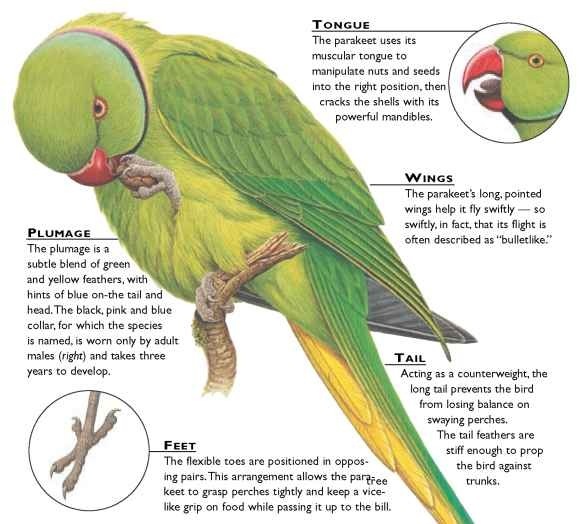
creature comparisons
Looking like a giant rose-ringed parakeet, the Alexandrine I parakeet (Psittacula eupatria) is the largest member of its genus. Both parakeets have the streamlined body shape shared by all parakeets, but the larger species is 23″ long, weighs up to II oz. and is equipped with a truly massive bill. It differs from its smaller relative in having a purple-red patch on the shoulders and a thicker, almost moustachelike collar
It’s possible to see the two species side by side in Sri Lanka and parts of southern India, but the Alexandrine parakeet is relatively uncommon and less tolerant of human activities.
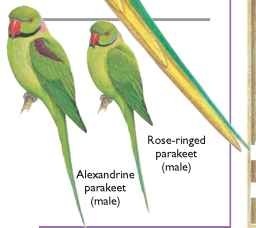
| VITAL | |
| STATISTICS | |
| Weight | 4-5 oz. |
| Length | 16-17″, including 8-10″ tail |
| WlNGSPAN | 19-20″ |
| Sexual Maturity 1- | 2-3 years |
| Breeding Season | December- June in India; December-April in Africa |
| Number of Eggs | 3-6 |
| Incubation Period | 22-24 days |
| Fledging Period Typical Diet |
50-55 days Fruit, seeds, nuts, nectar, buds; also raids crops and bird tables |
| Lifespan | 15-25 years |
RELATED SPECIES
• True parakeets are split into 4 genera. Psittacula includes the rose-ringed parakeet and 1 other species; Bolborhynchus and Brotogeris have 5 and 7 species, respectively; the monk parakeet is sole member of Myiopsitta. Parakeets belong to the family Psittacidae, with about 350 species, includ-| ing parrots, lovebirds and macaws. Almost a third of | the species in Psittacidae are currently endangered.
